Issue 11, September 13, 2019
Insects on milkweed in the home landscape
Throughout the summer I receive messages from landscape professionals and gardeners asking about insects on milkweed. Often people want to learn whether the insect they’ve encountered is a pest and sometimes they ask whether that insect may be a threat to monarch caterpillars they wish to encourage in the landscape. There are a plethora of different insect species that live on milkweed ranging from tiny aphids to large butterflies and voracious mantids. Here are some of the most common insect species on milkweed throughout the summer:
Herbivores
Monarch butterflies and caterpillars
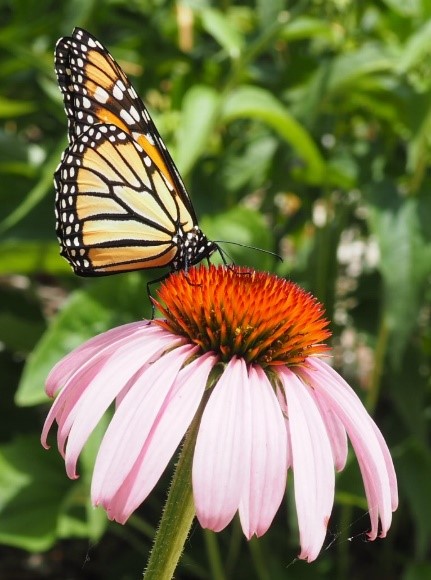
Monarch butterflies and caterpillars (Danaus plexippus) are among the most recognizable insect species in Illinois. Monarch caterpillars feed exclusively on the foliage of milkweed plants. Adult butterflies feed on nectar from a variety of flowering plants including prairie plants, ornamental plants and plants that are often considered weeds. Monarch butterflies provide pollinating services. Pollen sticks to their bodies and is transferred from plant to plant when they visit flowers to feed.
Monarchs sequester the milkweed’s natural plant defensive compounds in their bodies. These compounds make monarchs distasteful to many predators, providing a good natural defense.
Aphids
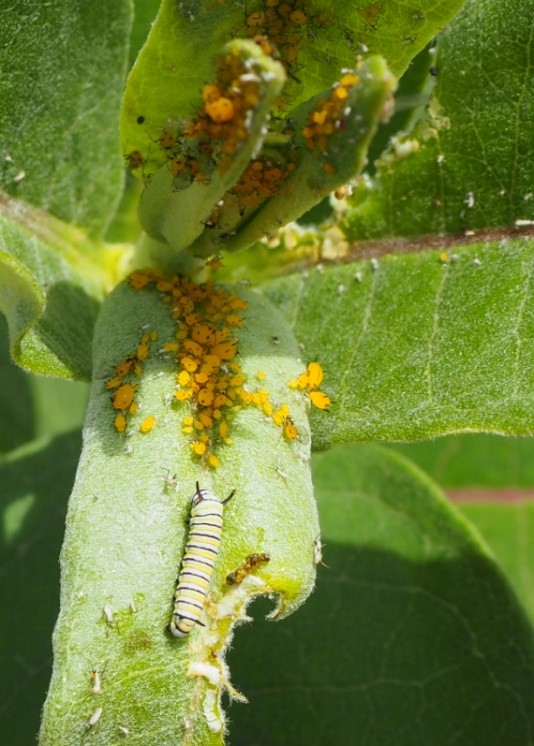
Aphids are tiny pear-shaped insects that suck the fluids from plants. Oleander aphid (Aphis nerii) is a common aphid on milkweed. These insects produce sugary droppings called honeydew which can coat leaves and support sooty mold. Dense populations can impact plant vigor but aphid populations are commonly parasitized and usually do not require control.
Aphids are sometimes tended by ants which can be problematic. Ants tending aphid colonies collect the sugary honeydew produced by the aphids and protect them from predators, preventing natural control of aphid populations. If the plant is stressed or if you are seeing dieback, it may be beneficial to treat aphids with an insecticidal soap or horticultural oil. However, these treatments may also harm young monarch caterpillars. The aphids will not harm monarchs but heavy aphid populations can stress the plants which can stress feeding caterpillars.
Milkweed bugs

Milkweed bugs (Oncopeltus sp.) are very common and active this time of year. Both adults and nymphs are orange to red and black. They use a straw-like mouthpart to feed on seeds within milkweed pods but they often wander to other parts of the plant and visit nearby plants. They will not harm monarchs and, because they feed on a different part of the plant, do not directly compete with them. They should not cause significant problems for the grower unless they intend to harvest milkweed seeds.
Milkweed tussock moth caterpillars
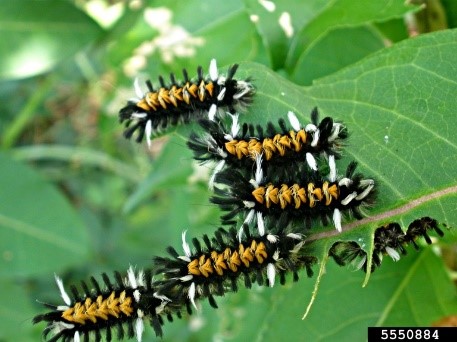
Milkweed tussock moth caterpillars (Euchaetes egle) are covered in tufts of orange, black and white hair. The tufts are in a tent-like arrangement along the length of the caterpillar’s back and stick out away from the body at the head and rear ends. It is more common to see these insects toward the end of summer when they reach this colorful life stage. This insect feeds on milkweed foliage and will not harm monarchs.
Swamp milkweed leaf beetles
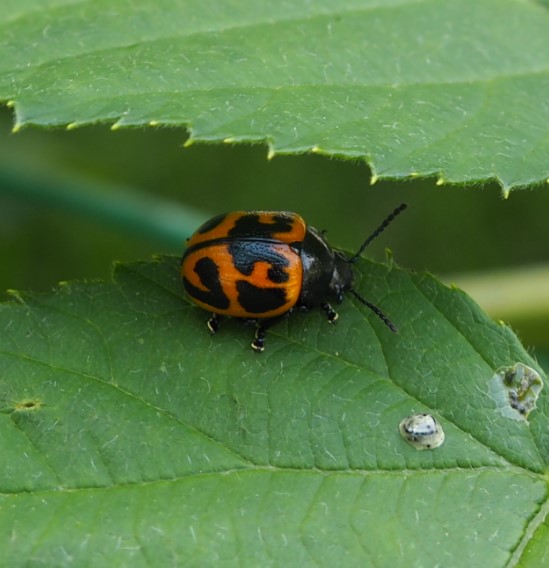
Swamp milkweed leaf beetle (Labidomera clivicollis) adults have orange wing covers with variable black patches. They are similar to lady beetles in body shape but they are larger. Larvae have robust fleshy abdomens that are gray to orange with a line of small black spots along each side. Swamp milkweed leaf beetles feed on the foliage of the milkweed plants as larvae and adults. They will not harm monarchs.
Milkweed longhorn beetles (Tetraopes sp.) have black antennae, red bodies and red wing covers with black spots. One of the major identification characteristics for longhorned beetles is that their antennae are longer than the length of their bodies. The adults feed on milkweed foliage and buds, lay eggs on milkweed stems and the larvae feed within milkweed roots. Milkweed longhorn beetle adults have bright coloration and are usually slow moving so they can be easily spotted, identified and observed. Milkweed longhorn beetles will not harm monarchs.
Milkweed longhorn beetles
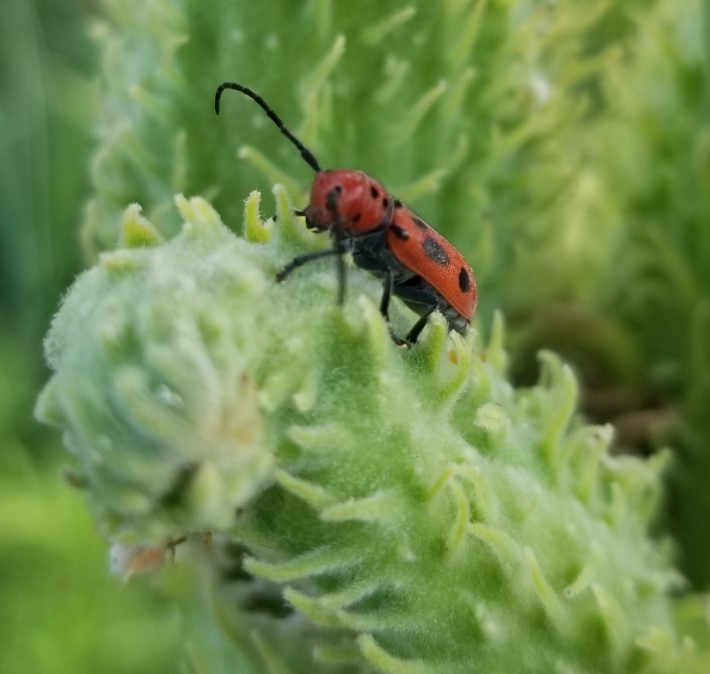
Milkweed longhorn beetles (Tetraopes sp.) have black antennae, red bodies and red wing covers with black spots. One of the major identification characteristics for longhorned beetles is that their antennae are longer than the length of their bodies. The adults feed on milkweed foliage and buds, lay eggs on milkweed stems and the larvae feed within milkweed roots. Milkweed longhorn beetle adults have bright coloration and are usually slow moving so they can be easily spotted, identified and observed. Milkweed longhorn beetles will not harm monarchs.
Insectivores
Lady beetles
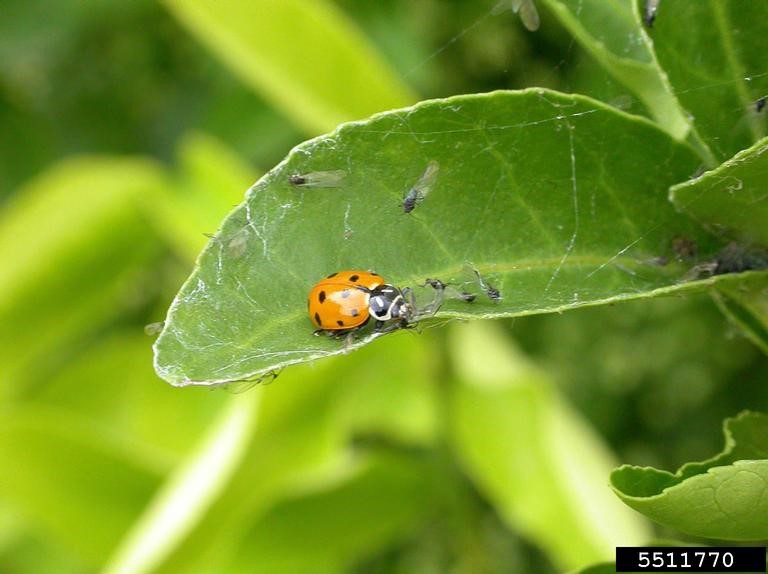
Lady beetles (family Coccinellidae) are another easily recognized insect, they have red wing covers with black spots and black and white hear and pronotum. Their larvae have long bodies with spike-like projections. They have three pairs of jointed legs near their head and are black and orange. Both the larvae and adults are insect predators, commonly found on milkweed. Lady beetles feed on tiny insects that live on milkweed, especially aphids. They do not harm monarchs.
Soldier beetles
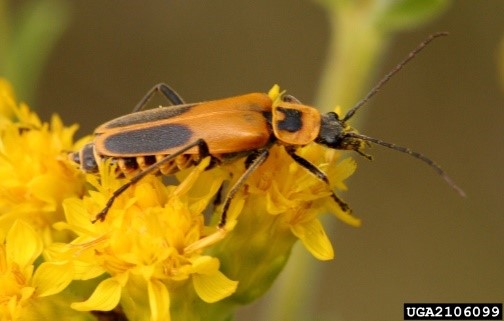
Adult soldier beetles (family Cantheridae) are omnivores, feeding on pollen and nectar from flowers and small insects like aphids. Soldier beetle larvae also feed on small insects in the soil. Adult beetles are orange with a black spot on each wing cover. This species is considered beneficial because they pollinate flowers and feed on small insects so control is not recommended.
Ambush Bugs
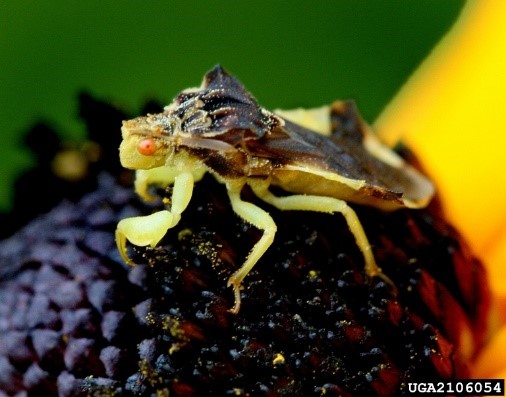
Ambush bugs (subfamily Phymatinae) are named for their predatory behavior. They sit still on milkweed and other plants, often on the flower, and wait for small prey insects to approach. When a prey insect is within reach, they grasp the insect with their raptorial forearms and begin to feed. They can feed on a variety of insect which can make them beneficial predators.
These insects are well camouflaged, with brown and yellow to green bodies. They can be distinguished from similarly shaped insects, like stink bugs or assassin bugs, by the shape of their forelegs which look similar to those of a praying mantis or Tyrannosaurus rex. While adult monarchs are too large and distasteful for this insect to capture, ambush bugs have the potential to consume young caterpillars.
Spined soldier bugs
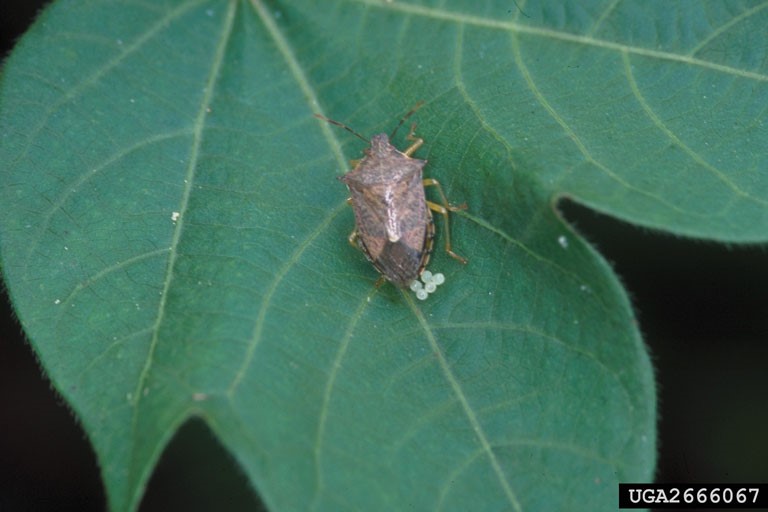
Spined soldier bugs (Podisus maculiventris) are predatory stink bugs. Adults are brown with a spine on each side of their pronotum (shoulder area). The young nymphs are often orange and black or green and black. These predators actively hunt and feed on prey insects. Their diet can include a range of insects which makes them beneficial predators in the landscape. However, their diet could include monarch caterpillars larger than themselves.
Praying mantids

Praying mantids (order Mantodea) are easily recognized by their long bodies and raptorial forelegs. There are two species of mantids in Illinois, the native Carolina mantis (Stagmomantis carolina) and the introduced Chinese mantis (Tenodera sinensis). The Chinese mantis is much larger than the Carolina mantis and has a yellow spot between its forelegs. Adult manitids are large enough to attack and consume an adult monarch butterflies but are unlikely to consume more than one because they learn that the monarchs are distasteful. They are also capable of consuming monarch caterpillars. They are unlikely to consume the caterpillars repeatedly because they are also distasteful. However, in laboratory studies some Chinese mantids learned to avoid milkweed material inside caterpillars by not consuming the caterpillar’s gut while feeding. If you or your clients are concerned about mantids feeding on monarchs, I recommend relocating mantids to an area without milkweed. Mantids can be beneficial predators in other parts of the garden or landscape. Pesticide applications on milkweed could be harmful to any insects that enter the area, including monarchs.
Image Credits:
Monarch (Danaus plexippus) adult on purple cone flower, Sarah Hughson, University of Illinois at Urbana-Champaign
Oleander aphid (Aphis nerii) and monarch caterpillar (Danaus plexippus) on milkweed, Sarah Hughson, University of Illinois at Urbana-Champaign
Milkweed bug on milkweed, Sarah Hughson, University of Illinois at Urbana-Champaign
Milkweed tussock moth (Euchaetes egle), Ansel Oommen, Bugwood.org
Swamp milkweed leaf beetle, Sarah Hughson, University of Illinois at Urbana-Champaign
Milkweed longhorn beetle on milkweed, Sarah Hughson, University of Illinois at Urbana-Champaign
Convergent lady beetle (Hippodima convergens), Jerrod Hein, Kansas State University, Bugwood.org
Goldenrod soldier beetle (Chauliognathus pensylvanicus), David Cappaert, Bugwood.org
Ambush bugs (Phymata sp.), David Cappaert, Bugwood.org
Spined soldier bug (Podisus maculiventris), John Ruberson, Kansas State University, Bugwood.org
Carolina mantis (Stagmomantis carolina), Sarah Hughson, University of Illinois at Urbana-Champaign